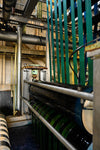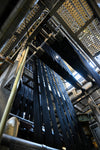Dyeing Processes
At Iron Heart, we use various dyes and dyeing techniques, utilising both modern and traditional methods. The dye and method we choose are dictated by how deep, bright, and colourfast we want the result to be. Unfortunately, regardless of the method, all dyeing processes consume a significant amount of water, CO₂, and energy.
We are well aware that our use of sulphur dyeing—whether in dyeing fabric or overdyeing garments post-construction—is not the most environmentally conscious choice. This technique uses sodium sulphide as a reducing agent to bond the colour particles to the surface of the fabric, but in doing so, it produces harmful gases and generates wastewater that poses a hazard to the environment.

However, in recent years, we’ve been actively researching and implementing alternatives to sodium sulphide, with the goal of eventually phasing out sulphur dyes entirely. We also recognise that any industrial dyeing process can pose a threat to the environment if by-products are not properly treated and disposed of. That’s why Iron Heart partners with some of the most respected and eco-conscious dyeing companies in Japan—companies that have invested heavily in state-of-the-art recycling and purification technologies.
Most, but not all, Iron Heart garments are one-washed post-production, to remove shrinkage and ensure the garment exits the process clean and fresh. However, unlike many other jeans manufacturers, we do not use any water or chemicals to "distress" or give a worn/aged look to any of our garments. Doing this massively reduces the amount of water used and also reduces the amount of dye that ends up in any given watercourse.
